A Guide to Professional Product Photography
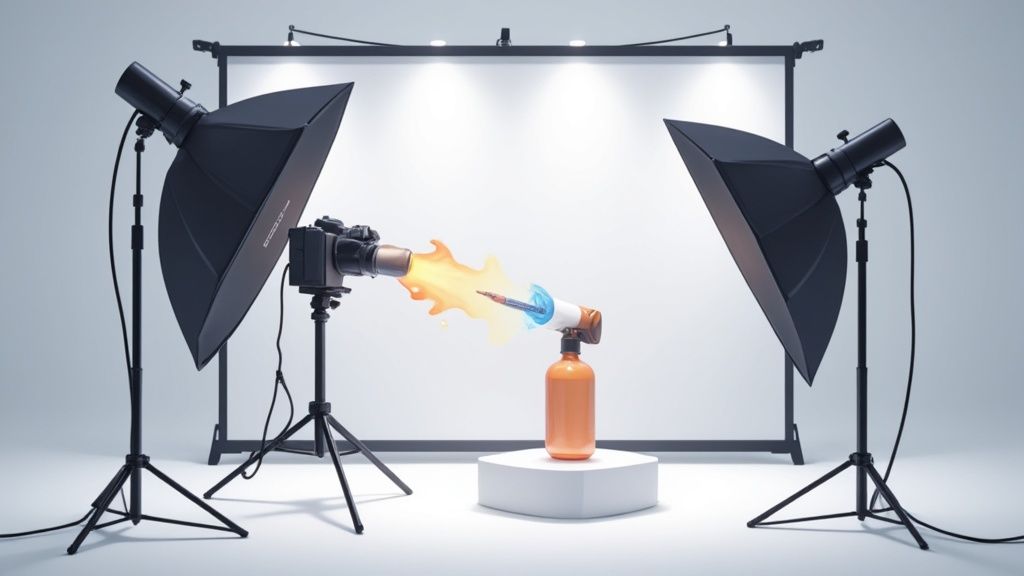
At its heart, professional product photography is both an art and a science—it’s the craft of taking stunning, high-quality images of products specifically for commercial use. This isn't just about snapping a quick picture. It’s a deliberate, strategic process focused on making an item look so good that it grabs a customer's attention and drives them to buy. For any brand selling online, these images are the absolute cornerstone of their digital storefront.
Why Great Product Photos Are Non-Negotiable
In the jam-packed world of e-commerce, your product photos are your single most important asset. They are your digital handshake, the very first interaction a potential customer has with what you're selling. We need to stop thinking of them as just "nice pictures" and start seeing them for what they are: a core business tool that shapes how people see your brand, builds trust, and directly grows your revenue.
Think about it from a shopper's perspective. A blurry, poorly lit photo screams low quality and a lack of professionalism, practically begging them to click away. But a crisp, beautifully composed image? That tells a story. It communicates value, highlights quality, and gives that shopper the confidence they need to hit "add to cart." This is why professional photography isn't just another expense—it's a fundamental investment in your brand's growth.
The Data-Driven Case for Quality Images
The numbers don't lie: fantastic visuals are directly tied to business success. For starters, visual content on social media gets 94% more views and triple the engagement of posts that are just text. This alone shows how much people crave compelling images.
Beyond that, brands that invest in professional-level photography consistently see much higher conversion rates. Why? Because clear, detailed, and attractive images build immediate trust with consumers. We dive deeper into how visual appeal drives sales in our guide on how to improve e-commerce conversion rates.
The infographic below really puts the impact of professional photos into perspective, showing how they influence key e-commerce metrics like sales, customer trust, and even product returns.
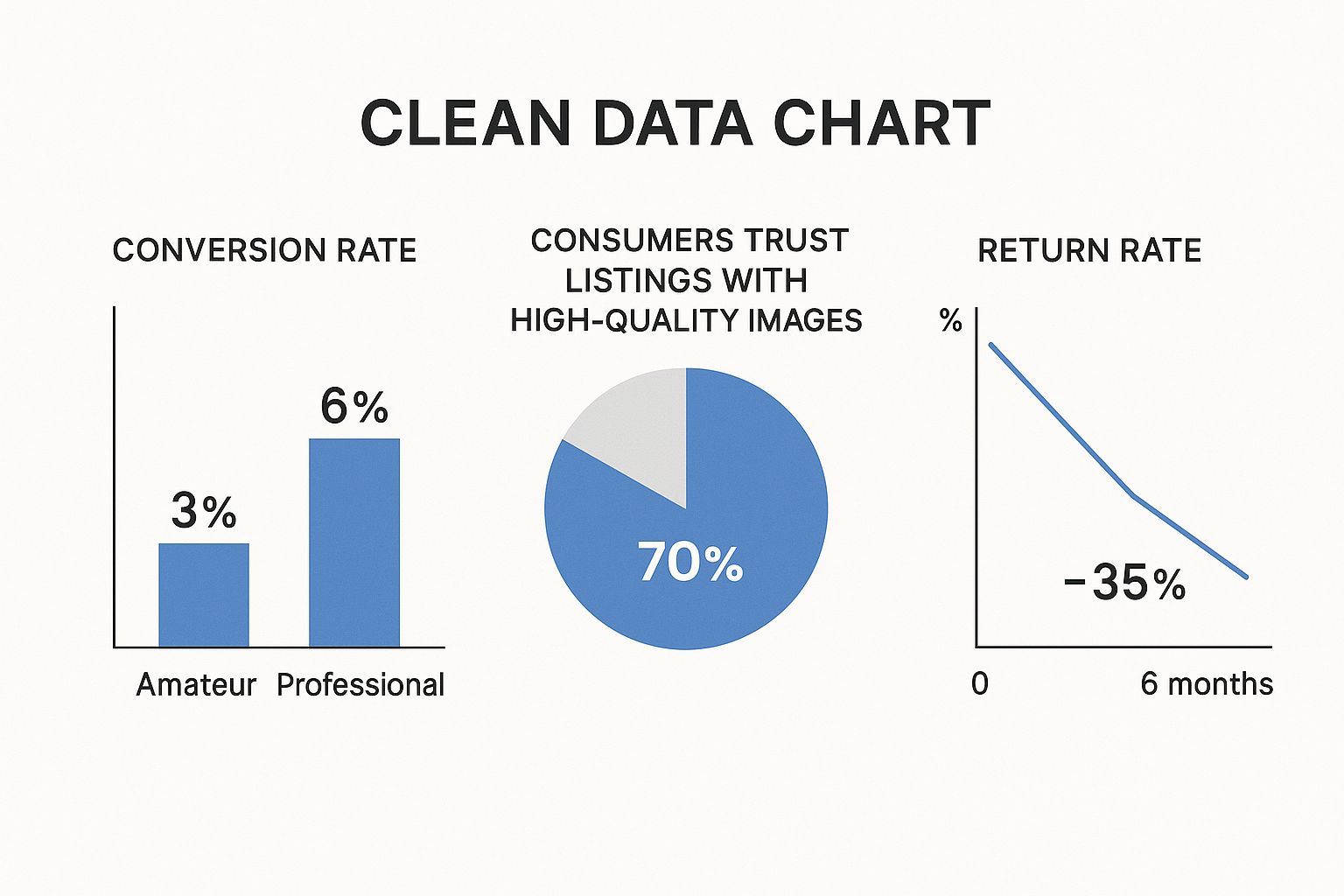
As you can see, making the leap from amateur shots to professional images can literally double your conversion rates while also building the kind of trust that helps slash costly returns.
To put it in simple terms, here's a quick look at the direct business impact you can expect.
Immediate Impact of Professional vs Amateur Photography
| Business Metric | Impact of Professional Photography | Impact of Amateur Photography |
|---|---|---|
| Conversion Rate | Significantly higher—often double or more. | Low and inconsistent, struggles to close sales. |
| Customer Trust | High. Builds confidence and credibility. | Low. Creates doubt and hesitation. |
| Brand Perception | Premium, trustworthy, and high-quality. | Cheap, unprofessional, or unreliable. |
| Product Returns | Lower. Customers know what to expect. | Higher. Images don't match the real product. |
The difference is stark. Professional images do more than just display a product; they actively build your business and strengthen your brand with every view.
Building Trust at First Glance
Ultimately, every product photo you display is a promise to your customer. High-quality photography keeps that promise by showing your product exactly as it is—the true color, the feel of the texture, and its actual size and scale.
This level of visual honesty is essential for building a strong, trustworthy brand. When customers feel they can rely on your images, they're not only more likely to make that first purchase but also to come back again and again. It’s a simple but incredibly powerful formula for long-term success.
Mastering the Fundamentals of Product Photography
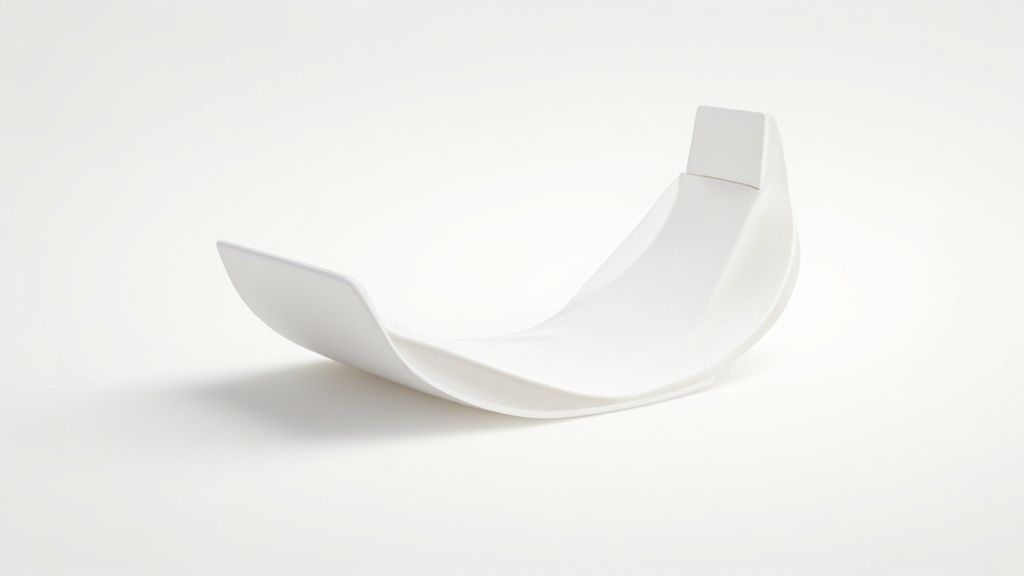
Great product photography really boils down to three things: lighting, angles, and backgrounds. Getting these right is like perfecting a recipe—the right combination makes the final dish incredible. Nail these fundamentals, and your images will look professional and draw people in. Get them wrong, and even the best product can look amateurish.
The idea is to stop just taking pictures of your product and start creating images that truly showcase it. Once you get a feel for these core pillars, you'll start to see how even tiny adjustments to your setup can completely change the mood, clarity, and overall punch of your photos.
Let's break each of them down.
Understanding Light and Shadow
If you only master one thing in product photography, make it lighting. Seriously. It’s the single most important element because it dictates the mood, defines shape, and brings out texture. The easiest way to think about it is by comparing it to sunlight.
Think about the sun at high noon on a clear day. The light is direct and intense, creating dark, sharp shadows. This is called hard light. It’s great for creating drama or making strong textures pop, but it can be harsh and unforgiving for a lot of products.
Now, picture a day with a light layer of clouds. The clouds act like a massive natural diffuser, scattering the sunlight and creating a soft, even glow. This is soft light. It gently wraps around your product, minimizes distracting shadows, and gives you that clean, polished look you see in most e-commerce shots.
For most products, especially for online marketplaces, soft, diffused light is the gold standard. It provides a clear and accurate representation of the product without distracting, dramatic shadows, making it easier for customers to see details.
Finding the Perfect Camera Angle
The angle you shoot from completely changes how a customer sees a product's shape, size, and even its purpose. A huge mistake beginners make is shooting everything head-on, which tends to make products look flat and boring. A little bit of perspective can bring an object to life.
Just a few key angles can make all the difference:
- The 45-Degree Angle: This is a classic for a reason. It shows the front and side of the product at the same time, giving it an immediate three-dimensional feel that reveals its depth and form.
- The Eye-Level Shot: Shooting at the product's level creates a straightforward, relatable view, almost like you're seeing it on a shelf right in front of you.
- The High Angle (Bird's-Eye View): This top-down shot is perfect for laying out items like apparel or creating a stylish "flat lay" arrangement with multiple products.
Moving your camera just a few inches can be the difference between a flat image and one that shows off a product's real texture and shape. For a much deeper dive into setting up your shots, our guide shows you exactly how to take professional product photos from start to finish.
Choosing the Right Background
Finally, let’s talk about the stage for your product—the background. A background can either make your product the star of the show or create a distracting mess that pulls the eye away. In professional photography, there are two main roads you can go down.
First, there's the clean white background, usually shot on what's called a white sweep. This is the undisputed standard for major marketplaces like Amazon. It strips away all distractions, forcing 100% of the viewer’s attention onto the product and creating a clean, consistent look across all your listings.
The other option is a styled or lifestyle background. This approach is all about telling a story by placing the product in a real-world setting. Think of a watch on someone’s wrist, a backpack out on a trail, or a coffee mug sitting on a cozy desk. These scenes help customers imagine the product in their own lives. A great product gallery uses both to give a complete picture.
The Art of Composition and Product Styling
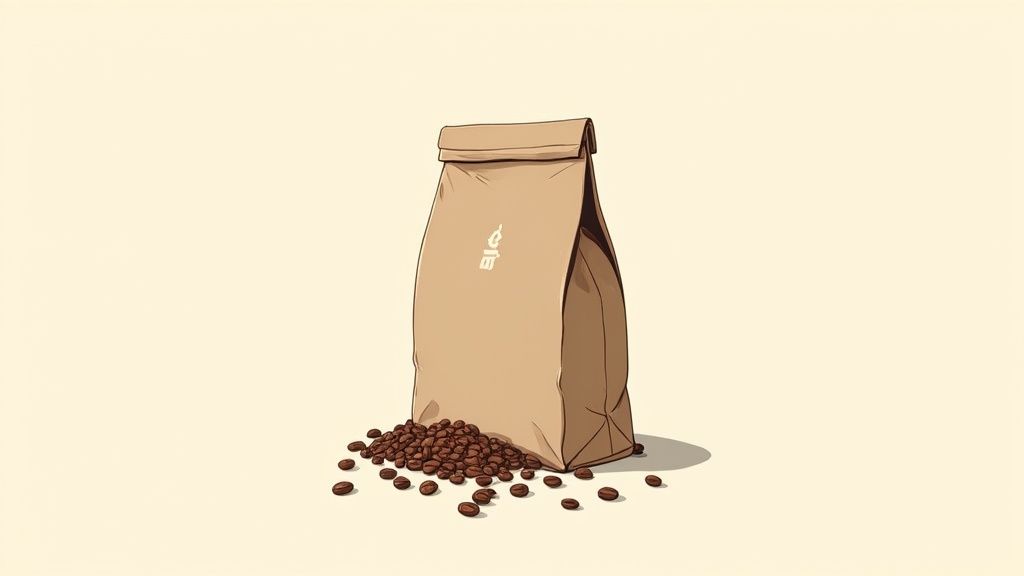
Getting the lighting and camera angles right will give you a technically flawless photo. But turning that photo into something that truly grabs attention and convinces someone to buy? That’s all about composition and styling. This is where you graduate from just taking pictures to becoming a visual storyteller, arranging every element in the frame to direct the viewer’s gaze and spark an emotional connection.
A great starting point is the rule of thirds. It’s a classic for a reason. Just picture your frame overlaid with a tic-tac-toe grid. Instead of sticking your product right in the middle, try placing it along one of the lines or where two lines intersect. This small adjustment immediately makes the image feel more dynamic, balanced, and professional.
Thinking this way helps you decide what type of shot will work best for what you’re trying to achieve. In product photography, this usually boils down to two main approaches: hero shots and group photos.
Hero Shots Versus Group Photos
A hero shot is exactly what it sounds like: one stunning, standalone image of your product. It’s the star of the show, typically set against a clean, simple background so there are absolutely no distractions. This is your go-to for the main image on a product page because it presents what you’re selling with crystal clarity.
A group photo, on the other hand, brings multiple products together in a single frame. This approach is fantastic for showcasing an entire collection, a special bundle, or different options like colors and sizes. A well-staged group shot can show off your range and tempt customers to check out more of your offerings, essentially upselling them with a single picture.
The real magic happens when you use both. Kick off your image gallery with a powerful hero shot, then follow it up with group photos and detailed close-ups. This gives shoppers a complete, persuasive look at what they’re getting.
Styling with Purpose and Context
Beyond how you arrange your products, product styling is the secret sauce. It’s about carefully choosing props and creating a scene that tells a story. The goal here isn’t just to fill the space; it’s to add meaning and context. Any prop you use should elevate the product, never steal the spotlight.
Think about it: a luxury watch just sitting there is one thing, but a photo of it on someone's wrist instantly communicates sophistication and real-world appeal. A bag of gourmet coffee beans becomes far more enticing when it’s next to a rustic mug and a few artfully scattered beans, creating a scene that feels warm and aromatic.
These details help customers see the product as part of their own lives. It’s all about the power of visual storytelling. By selecting props that complement your product’s identity, you build a narrative that transforms a simple object into something your customers absolutely need to have.
Why Product Photography is a Bigger Deal Than Ever
To really get why professional photos are worth the investment, you have to look at the bigger picture. This isn't just about pretty pictures; it's about a massive global market that's booming for some very specific reasons. Once you see the forces at play, it becomes clear that top-notch visuals are no longer optional—they're a core part of any modern business.
The single biggest driver? E-commerce. It's an absolute explosion. As more and more businesses flock online, the need for amazing, eye-catching images has gone through the roof.
Think about it: your product photos aren't just sitting on your website anymore. They're your frontline soldiers on Instagram, your silent salespeople on Facebook Marketplace, and your brand ambassadors across dozens of digital channels where people decide to buy in a split second. This change has put photography right at the heart of marketing.
The Numbers Don't Lie
We're living in a visual-first world. People would rather see a great photo than read a block of text, and that simple fact has turned professional photography into a must-have for anyone selling online. It’s how you grab attention and, more importantly, how you build trust with shoppers who can't touch your product.
The market data backs this up completely. The global photography services industry, which heavily includes professional product photography, is on a serious upward climb. It was valued at around $55.6 billion in 2023** and is on track to hit a staggering **$81.83 billion by 2032.
This isn't a fluke. It's a clear signal that businesses everywhere are doubling down on their visual assets. You can dig into these photography industry statistics to get a sense of just how big this wave is.
In today's crowded marketplace, professional product photography isn’t a luxury—it’s a foundational investment. The market’s unstoppable growth proves it’s an essential tool for boosting sales and creating a brand that people remember.
A Look at Global Trends
This growth isn't happening in a vacuum; different parts of the world are contributing in their own ways. Seeing where the momentum is can give you a better sense of the global landscape you're competing in.
- Asia-Pacific: This region is the powerhouse, holding a massive 35% share of the market. It's all thanks to the incredible pace of digital adoption and growing spending power in places like China and India.
- North America: Not far behind, North America accounts for 28% of the market. Here, the growth is driven by cutting-edge tech and a really mature, sophisticated commercial photography scene.
Knowing this helps you place your own business in a global context. When you see just how healthy and vital the photography industry is, you can invest in your own visual strategy with confidence, knowing you’re putting your money where the market is headed.
How AI Is Flipping the Script on Photo Editing
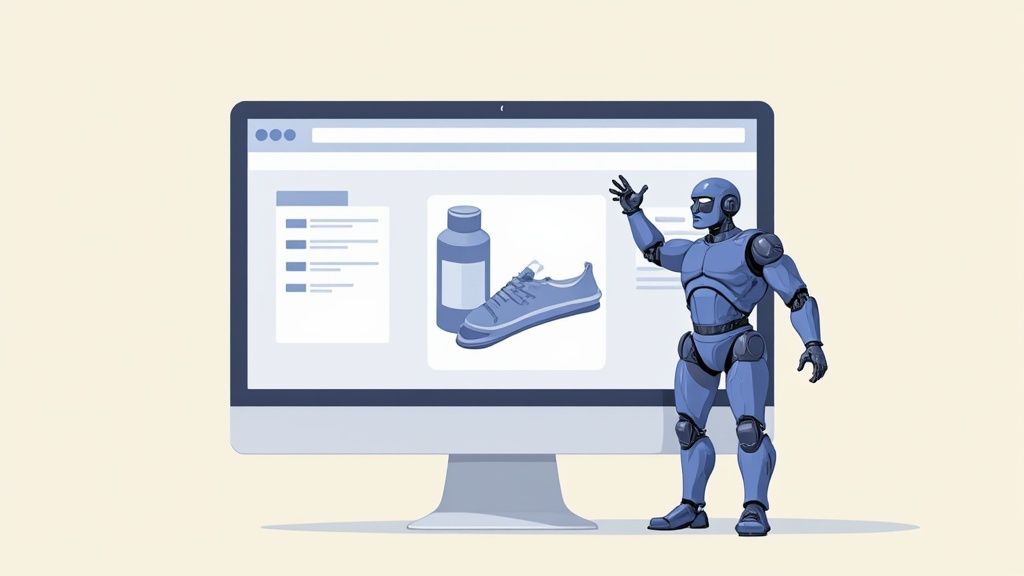
For years, the biggest headache in product photography wasn't the shoot itself—it was the editing. Post-production was a serious bottleneck, a manual grind of tracing product outlines, tweaking color balances pixel by pixel, and zapping tiny blemishes. This wasn't just slow; it was expensive, demanding hours of skilled work that delayed getting products online.
Now, artificial intelligence has entered the chat, and it's not just a minor update. It’s like having a team of expert photo editors on call, ready to work at impossible speeds. These AI tools take on the most boring, repetitive editing tasks with incredible accuracy. This frees up photographers and creative teams to do what they do best: focus on the art of the shot, not the tedium of post-production.
Putting Tedious Tasks on Autopilot
The most immediate win with AI is how it handles the complex, time-sucking jobs that used to take hours. For any e-commerce brand, this translates directly into more time and money back in your pocket. Suddenly, professional-grade photography is within reach for everyone.
Here’s where AI really shines:
- Flawless Background Removal: No more tedious outlining. AI instantly identifies your product and lifts it from its background, ready to be placed on a clean white backdrop or dropped into a custom scene.
- Smart Object Cleanup: Got a spec of dust on the lens? A weird reflection? AI can remove these imperfections with a click, intelligently rebuilding the area behind them so it looks like they were never there.
- Perfect Color Consistency: Feed the AI one perfectly edited reference photo, and it can apply that exact lighting, color, and shadow profile across thousands of other images. Your entire product catalog will look perfectly cohesive.
This kind of automation used to be the stuff of science fiction, but it's quickly becoming the new normal. For anyone producing lots of product images, these tools are no longer a luxury—they're essential.
By automating routine edits, AI drastically shortens the production timeline. What used to take a team of editors days to complete can now be finished in a fraction of the time, allowing brands to launch products faster and react more quickly to market trends.
More Than Just Speed: A Creative Game-Changer
AI isn't just about doing the old tasks faster; it's about unlocking new creative avenues. When your team isn't bogged down by the technical grunt work of editing, they have the bandwidth to experiment. They can test different styles, refine their visual storytelling, and think more strategically about what makes a customer click "buy."
If you want to dig deeper into how AI is completely reshaping the creation of product visuals, check out this excellent guide on AI Product Photography.
The benefits are straightforward: you get your images back faster, your operating costs go down, and your brand maintains a polished, consistent look everywhere. Bringing AI into the editing workflow is a massive leap forward. It handles the heavy lifting, empowering brands of all sizes to create better images, faster.
We've also written more on this topic if you'd like to learn more about AI product photography.
Measuring the Financial Return of Quality Visuals
Let's talk brass tacks. Pouring money into professional product photography isn't just an expense you write off; it’s a direct investment in your bottom line. The line connecting great images to financial results is surprisingly straight, starting with the single most important metric for any online store: your conversion rate.
Think about it: compelling visuals are your silent, 24/7 salesperson. They answer a customer's unspoken questions in a single glance and build the trust they need to finally click "Add to Cart."
https://www.youtube.com/embed/kW6HvwfyExs
But the payoff doesn't stop once the sale is made. One of the biggest, often overlooked, financial wins is a major drop in product returns. When your customers can see the product clearly from every angle, with true-to-life colors and textures, what they get in the mail matches what they saw online.
This simple act of setting clear expectations dismantles the entire costly, time-sucking process of handling returns, dealing with customer service, and restocking inventory.
Investing in high-quality visuals is not just about making products look good; it's a proven strategy for increasing conversions, reducing returns, and strengthening your brand’s financial health in a competitive digital marketplace.
The Statistical Proof
If you need more convincing, just look at the numbers. The market for professional product photography is a huge slice of the broader photography platform industry, which is on track to become an $18.4 billion global powerhouse by 2025.
What’s driving this explosive growth? Visual-first marketing. E-commerce brands that go all-in on high-quality images consistently report an average 30% jump in their conversion rates. The financial impact isn't theoretical; it's right there in the data. You can dig into more photography platform marketing statistics to see the full scope.
At the end of the day, every dollar you spend on getting your photography right is a dollar invested in real, sustainable growth.
Common Questions About Product Photography
Stepping into professional product photography can feel like learning a new language. You've got questions, and that's a good thing—it means you're focused on getting it right. Let's break down some of the most frequent queries we hear from brand owners and marketers.
How Much Should I Actually Budget for Photography?
There’s no one-size-fits-all answer here. Your budget really hinges on a few key things: how complex your products are, how many shots you need, and the photographer’s level of experience.
For simple e-commerce shots on a clean white background, you'll often find photographers charge per image. But if you’re looking for a more elaborate lifestyle shoot showing your product in action, that’s usually billed as a day rate.
The best move? Reach out to a few photographers for quotes. Look through their portfolios to see if their style clicks with your brand's vibe. Always remember, you’re not just buying pictures; you’re investing in your most powerful sales assets. Good photos pay for themselves time and time again.
Don't think of product photography as a business cost. Treat it as a direct investment in your #1 sales tool. The ROI from professional images—through higher conversions and fewer returns—almost always dwarfs the initial price tag.
Can't I Just Take the Photos Myself?
Look, DIY photography is definitely an option, especially if you're just starting out and the budget is tight. But a professional brings an entirely different level of skill to the table. They’ve spent years mastering the nuances of lighting, composition, and editing—the very things that make a product look premium and trustworthy.
Doing it yourself can be a great first step. But as your business scales, investing in professional work becomes a non-negotiable part of competing seriously. It’s what elevates your brand and creates the consistent, polished look that shoppers now demand.
How Many Photos Should I Have for Each Product?
For most e-commerce platforms, the sweet spot is 5-8 photos per product. That range gives customers the full picture, letting them buy with confidence.
Think of it like telling a complete story:
- The Hero Shot: Your main image, the one that grabs all the attention.
- Different Angles: Show the front, back, and sides so there are no surprises.
- The Close-Up: This is where you show off quality, texture, and fine details.
- In-Context: A lifestyle shot that shows the product being used in a real-world setting.
Covering all these bases builds a ton of trust and is a proven way to cut down on product returns.
Ready to get high-end product images without the hassle and expense of a full-blown photoshoot? QuickPixel uses AI to turn your simple photos into studio-quality shots that are perfect for any online store. See how professional-grade images can change the game for your brand. Learn more and get your photos edited at QuickPixel.
Try QuickPixel Today
Get started with our AI-powered image generation tools